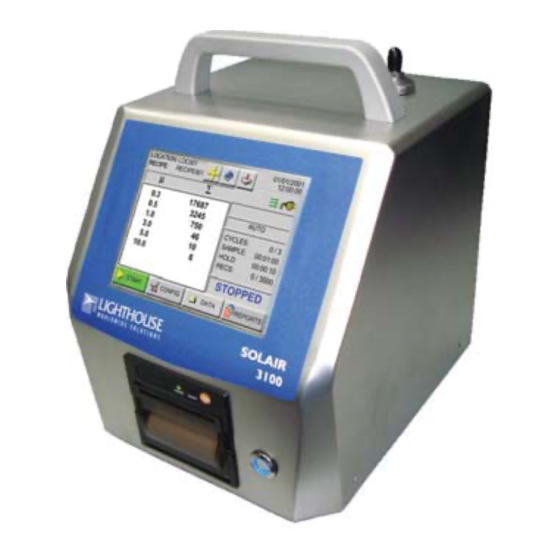
Table of Contents
Advertisement
Quick Links
Advertisement
Table of Contents
Troubleshooting

Summarization of Contents
About this Manual
Text Conventions
Explains typefaces used in the manual for clarity and emphasis.
General Safety
Safety Considerations
Outlines general safety warnings and classifications for operating the instrument.
LASER Safety Information
Details safety precautions related to the product's laser-based sensor and potential radiation exposure.
Introduction
Overview
Introduces the SOLAIR 1.0 CFM particle counters and their capabilities.
SOLAIR Specifications
Lists detailed technical specifications for the SOLAIR 3100, 5100, and Boulder Counter models.
Unpacking, Inspecting and Installing
Unpacking
Provides instructions for carefully unpacking the instrument and checking for shipping damage.
Accessories
Lists and describes optional and standard accessories available to enhance instrument functionality.
Installation
Covers the initial steps for installing the instrument, including connecting power and installing the battery.
Setting up the Counter
Analog Sensors
Explains how to connect and configure up to four 4-20mA analog sensors using RJ-12 cables.
Analog Setup
Details the process of configuring analog sensors, including setting MIN/MAX values and units in the SOLAIR firmware.
Ethernet Configuration
Guides users through configuring the SOLAIR's Ethernet port for network connectivity using DHCP or static IP.
Program the Interface
Provides instructions for programming the interface using Windows Telnet, including ARP commands.
Communications
SOLAIR Communication Mode
Explains the available communication ports and modes for the SOLAIR instrument.
Ethernet Communications
Details how to establish Ethernet connectivity using the MODBUS over TCP/IP protocol.
USB Communications
Explains point-to-point communication via the USB port and the necessary driver installation.
USB Flash Drive
Describes how to use the USB flash drive for saving reports and data, including file formats.
Operating Counter
Using the Instrument for the First Time
Provides step-by-step instructions for setting up and starting the SOLAIR for initial operation.
MAIN Screen
Details the information and options displayed on the MAIN screen, providing a snapshot of instrument status.
SAMPLE
Describes how to configure sample parameters like cycles, delay, hold time, and sample time for running measurements.
ALARM
Guides users on enabling particle alarms for specific channels and setting alarm thresholds.
Maintenance Procedures
Calibration
Recommends annual recalibration by an authorized service provider for optimal instrument performance.
Troubleshooting
Provides guidance on troubleshooting common issues, particularly if the Purge Count test fails.
Default Settings
Default Settings for SOLAIR Particle Counters
Lists the default configuration settings for SOLAIR particle counters, serving as a reference.
MODBUS Register v1.48
Sensor Settings Registers
Provides a map of sensor settings registers, detailing their purpose and data types.
Command Register
Details the Command Register (40002) used to execute actions and commands on the device.
Data Registers
Describes the data registers (30xxx series) where particle and analog data are stored, including their format.
Real Time Flow and Laser Current via MODBUS
Procedure for Computer to Instrument only
Provides steps for connecting the instrument to a computer and reading real-time data via MODBUS.
Limited Warranty
Limitation Of Warranties:
Outlines limitations and exclusions of the product warranty provided by Lighthouse Worldwide Solutions.










Need help?
Do you have a question about the solair 5100 and is the answer not in the manual?
Questions and answers